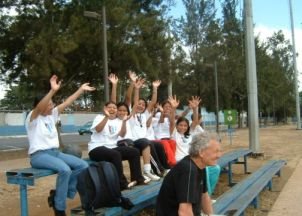Study Guatemala - the History

In 2001 the charity began as a scholarship system for the children of underprivileged families in Guatemala City. The idea for the project arose as a result of discussions between -Sr. Eduardo Estrada Espel, a teacher in the Guatemalan public school system, who for over 20 years has devoted himself to helping young people in the city- and Phil Melling, who became aware of the educational problems as a result of visiting his son, Tom, in Guatemala City. They all consulted with Jane Aitman, who had previously worked with Sr. Espel in Guatemala City. In the subsequent conversations Sr. Espel identified the lack of secondary education as an area of primary need. He also suggested that the principle cause of illiteracy could only be addressed once the financial burden of attending school was completely removed. The scholarship programme attempted to rectify these problems by subsidising the cost of secondary education for the most disadvantaged. It allowed 15 children to remain at school after the age of 11 when, ordinarily, they would look to support their families by working on the streets. The students Sr. Espel selected did remarkably well. In order to develop the scholarship initiative further into a sustainable programme with a much bigger impact, it was decided to apply for Charitable Trust status in the United Kingdom. Phil Melling and Jane Aitman successfully completed this application.
In 2003 The charity Study Guatemala became registered in the UK. Work began towards the setting up of an educational centre in the city. In order to achieve this, the charity provided financial support for the rental of a building in Zone 5 of the city. Over the summer of 2003 the building was transformed into a fully equipped school. Teachers were appointed together with a secretary and an on-site director, Senor Espel. Swansea City council in Wales donated a substantial number of computers and printers to equip the school and supporters donated funding for computer tables and chairs. These were shipped to Guatemala City by Phil Melling and were installed in December 2003. In 2004 the school was registered with the Ministry of Education in Guatemala City and Liceo Britanico Guatemalteco - an independent educational centre, free at the point of entry to those in need began its life. The school opened for classes on January 12th, 2004 and is currently assisting pupils from the ages of 11-16. In March 2010, after incredible fundraising efforts from all the trustees and supporters of the charity, which included 2 treks in Guatemala, organised by the late Chairman of the charity, Phil Melling, Study Guatemala achieved the great success of purchasing land and subsequently constructing its own school building. This school opened in March 2010. Now without the financial demands of rent, the long term sustainability of Liceo Britanico Guatemalteco began to become a reality.
From offering education to 31 students in 2003, the school now has a much larger school population. They are boys and girls mostly from the local community and the most marginal groups in the city. Year after year, the pupils achieve outstanding educational results. They also take part in may extra curricular activities. The biggest of these is the school band which has been exceptionally successful winning many competitions. When the students leave the school they usually obtain employment, often take up professional careers and some progress to further educational institutions. This dramatically affects their wellbeing and that of their families. As a result of continued fundraising we have now built a 3rd storey onto the building which is a huge asset to the school and it provides a fully equipped science laboratory and a large multi-purpose area.
In 2003 The charity Study Guatemala became registered in the UK. Work began towards the setting up of an educational centre in the city. In order to achieve this, the charity provided financial support for the rental of a building in Zone 5 of the city. Over the summer of 2003 the building was transformed into a fully equipped school. Teachers were appointed together with a secretary and an on-site director, Senor Espel. Swansea City council in Wales donated a substantial number of computers and printers to equip the school and supporters donated funding for computer tables and chairs. These were shipped to Guatemala City by Phil Melling and were installed in December 2003. In 2004 the school was registered with the Ministry of Education in Guatemala City and Liceo Britanico Guatemalteco - an independent educational centre, free at the point of entry to those in need began its life. The school opened for classes on January 12th, 2004 and is currently assisting pupils from the ages of 11-16. In March 2010, after incredible fundraising efforts from all the trustees and supporters of the charity, which included 2 treks in Guatemala, organised by the late Chairman of the charity, Phil Melling, Study Guatemala achieved the great success of purchasing land and subsequently constructing its own school building. This school opened in March 2010. Now without the financial demands of rent, the long term sustainability of Liceo Britanico Guatemalteco began to become a reality.
From offering education to 31 students in 2003, the school now has a much larger school population. They are boys and girls mostly from the local community and the most marginal groups in the city. Year after year, the pupils achieve outstanding educational results. They also take part in may extra curricular activities. The biggest of these is the school band which has been exceptionally successful winning many competitions. When the students leave the school they usually obtain employment, often take up professional careers and some progress to further educational institutions. This dramatically affects their wellbeing and that of their families. As a result of continued fundraising we have now built a 3rd storey onto the building which is a huge asset to the school and it provides a fully equipped science laboratory and a large multi-purpose area.

